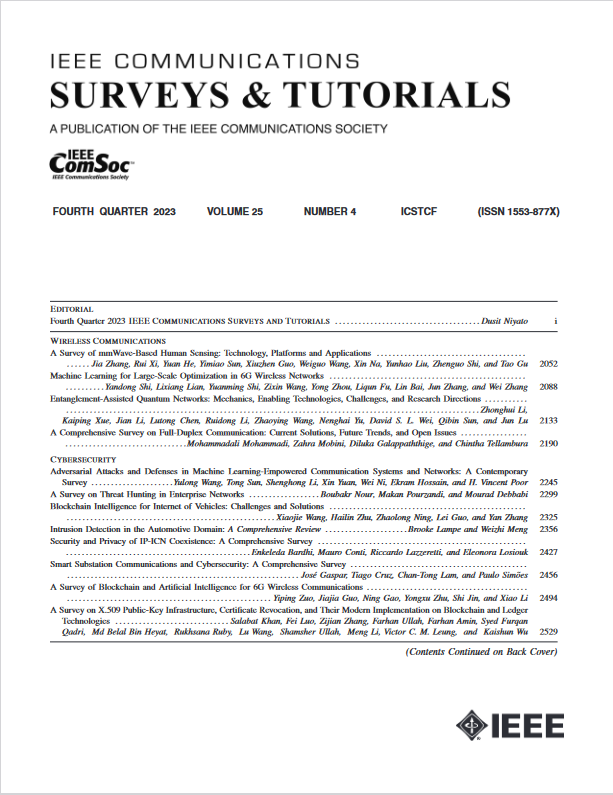UAV-Assisted Communications With RF Energy Harvesting: A Comprehensive Survey
IF 34.4
1区 计算机科学
Q1 COMPUTER SCIENCE, INFORMATION SYSTEMS
引用次数: 0
Abstract
Unmanned aerial vehicles (UAVs) have recently achieved sky-rocketed prominence in assisting various wireless communication scenarios due to their implicit characteristics like line-of-sight connectivity, three-dimensional mobility, on-demand deployment, and payload abilities. For realizing UAV-assisted communications in practical scenarios, one of the key challenges is the onboard power limitation of UAVs, which can affect their flight duration, maneuverability, and network lifetime. Exploiting energy harvesting (EH) techniques with UAV networks can improve operational time by addressing the UAV’s power constraints. In addition, UAVs can facilitate seamless connectivity for energy-constrained low-power devices in remote locations, disaster-struck areas, emergencies, and areas where human intervention is challenging and recharging or replacing batteries is problematic. In such scenarios, a low-altitude UAV, which flies flexibly, can serve as a radio-frequency (RF) energy transmitter to charge the nearby low-power devices efficiently and help enable their communications. Focusing on these aspects, this paper comprehensively surveys the current state-of-the-art EH techniques that can be utilized with UAV communications in various practical scenarios. Then, we highlight crucial challenges in integrating UAVs with prevailing wireless infrastructure and discuss different RF-EH receiver architectures that can be viable solutions for power-constrained UAV networks. Further, we show the channel modeling of UAV-assisted communications with EH and provide critical insights into the system performance. Besides, we offer an exhaustive review of recent works on RF-EH in UAV networks with next-generation paradigms and different problem-solving techniques/optimization methods. Finally, we suggest forthcoming trends and highlight open issues and future research directions.利用射频能量收集的无人机辅助通信:全面调查
由于无人机具有视距连接、三维机动性、按需部署和有效载荷能力等隐性特征,无人机最近在协助各种无线通信场景方面取得了飞速发展。为了在实际场景中实现无人机辅助通信,无人机机载功率限制是一个关键挑战,它会影响无人机的飞行时间、机动性和网络寿命。利用无人机网络的能量收集(EH)技术可以通过解决无人机的功率限制来改善操作时间。此外,无人机还可以为偏远地区、受灾地区、紧急情况以及人工干预困难、充电或更换电池有问题的地区的能源受限低功耗设备提供无缝连接。在这种情况下,灵活飞行的低空无人机可以作为射频(RF)能量发射器,有效地为附近的低功率设备充电,并帮助它们实现通信。围绕这些方面,本文全面综述了当前最先进的EH技术,这些技术可以在各种实际场景中用于无人机通信。然后,我们强调了将无人机与主流无线基础设施集成的关键挑战,并讨论了不同的RF-EH接收器架构,这些架构可以成为功率受限的无人机网络的可行解决方案。此外,我们展示了无人机辅助EH通信的信道建模,并提供了对系统性能的关键见解。此外,我们还对无人机网络中RF-EH的最新研究进行了详尽的回顾,这些研究采用了下一代范式和不同的问题解决技术/优化方法。最后,我们提出了未来的发展趋势,并强调了开放性问题和未来的研究方向。
本文章由计算机程序翻译,如有差异,请以英文原文为准。
求助全文
约1分钟内获得全文
求助全文
来源期刊

IEEE Communications Surveys and Tutorials
COMPUTER SCIENCE, INFORMATION SYSTEMS-TELECOMMUNICATIONS
CiteScore
80.20
自引率
2.50%
发文量
84
审稿时长
6 months
期刊介绍:
IEEE Communications Surveys & Tutorials is an online journal published by the IEEE Communications Society for tutorials and surveys covering all aspects of the communications field. Telecommunications technology is progressing at a rapid pace, and the IEEE Communications Society is committed to providing researchers and other professionals the information and tools to stay abreast. IEEE Communications Surveys and Tutorials focuses on integrating and adding understanding to the existing literature on communications, putting results in context. Whether searching for in-depth information about a familiar area or an introduction into a new area, IEEE Communications Surveys & Tutorials aims to be the premier source of peer-reviewed, comprehensive tutorials and surveys, and pointers to further sources. IEEE Communications Surveys & Tutorials publishes only articles exclusively written for IEEE Communications Surveys & Tutorials and go through a rigorous review process before their publication in the quarterly issues.
A tutorial article in the IEEE Communications Surveys & Tutorials should be designed to help the reader to become familiar with and learn something specific about a chosen topic. In contrast, the term survey, as applied here, is defined to mean a survey of the literature. A survey article in IEEE Communications Surveys & Tutorials should provide a comprehensive review of developments in a selected area, covering its development from its inception to its current state and beyond, and illustrating its development through liberal citations from the literature. Both tutorials and surveys should be tutorial in nature and should be written in a style comprehensible to readers outside the specialty of the article.
 求助内容:
求助内容: 应助结果提醒方式:
应助结果提醒方式:


